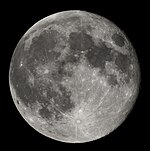General Astronomy/Earth's Moon

The Moon has no atmosphere due to its weak gravity. It is composed of a 800 km thick lithosphere, covering a core of thin magma. The moon is a complex body in the solar system. Moon rocks are composed of minerals including aluminum, calcium, magnesium, oxygen, silicon, and titanium. Some gases are also trapped in these rocks, such as hydrogen and helium. These gases are said to have reached the moon by solar wind From studying the moon astronauts have found two different types of rocks basalt and breccias. Basalt is formed from hardened lava. Breccias are formed from soil and rock that have been squeezed together when hit by falling objects. The moon’s composition has always been interesting to scientists because it is so different than Earth’s is. With information that has been discovers and found it makes it easier to know what and how the moon works.
Moon Composition compared to the Earth
| Moon | Earth | Ratio | |
|---|---|---|---|
| Mass(1024 kg) | 0.07349 | 5.9736 | 0.0123 |
| Mean density (kg/m3) | 3350 | 5515 | 0.607 |
| Surface gravity (m/s2) | 1.62 | 9.80 | 0.165 |
| Surface acceleration (m/s2) | 1.62 | 9.78 | 0.166 |
| Diameter(km) | 3,474 | 12,756.32 | .2723 |
The Moon has two types of landscapes: bright, cratered highlands in the south, and dark mare basins in the north. One side of the moon always faces the earth; this side has many more mare basins.
From Earth the moon appears smooth but that is not the case of the true surface. The geography of the moon is dominated by impact craters. There are about half a million craters with diameters greater than 1 km on the moon. Due to the fact that the moon’s has no atmosphere it takes millions of hits of steroids and other flying debris in the solar system. The Moon actually takes saves the Earth because if the moon was not there to take the hits from the asteroids, the asteroids would plow straight in the Earth.
Rilles (narrow valleys) on the Moon sometimes resulted from the formation of localized lava channels. These generally fall into three categories, consisting of sinuous, arcuate, or linear shapes. By following these meandering rilles back to their source, they often lead to an old volcanic vent. One of the most notable sinuous rilles is the Vallis Schröteri feature, located in the Aristarchus plateau along the eastern edge of Oceanus Procellarum. (Earth’s Moon)
Domes, a variety of shield volcanoes can be found in selected locations on the lunar surface, such as on Mons Rümker. These are believed to be formed by relatively viscous, possibly silica-rich lava, erupting from localized vents. The resulting lunar domes are wide, rounded, circular features with a gentle slope rising in elevation a few hundred meters to the midpoint. They are typically 8–12 km in diameter, but can be up to 20 km across. Some of the domes contain a small pit at their peak.
The major products of volcanic processes on the Moon are evident to the Earth-bound observer in the form of the lunar maria. The lunar Maria is the moon’s version of a sea. These are large flows of basaltic lava that correspond to low-albedo surfaces covering nearly a third of the near side. Only a few percent of the far side has been affected by mare volcanism. Even before the Apollo missions confirmed it, most scientists believed that the maria were lava-filled plains, since they possessed lava flow patterns and collapses attributed to lava tubes(
Primary lunar craters were caused by meteors. Secondary craters were caused by debris. Lunar craters have rays around the edges. These are caused by the debris from meteors: since the moon has weak gravity and no atmosphere, it sprays out for a long distance.
Erosion is much slower on the moon than on the Earth. It is estimated that Buzz Aldrin's footprint will last 10 million years!

The maria (plural of mare) were caused by big asteroids strikes which ruptured the Lunar crust and released internal lava to flow up into the impact craters and flood-fill the bottom of the crater out to the crater walls. The lava solidified into basalt, creating the large, dark basins. This iron-rich basalt creates tension in the maria basins. This sometimes causes the crust to crack, forming graben.
Early in the moon's history, meteoric impacts caused the surface to melt. The liquid lunar surface underwent differentiation: the heavier iron sunk, while lighter aluminum rose to the top. The core was kept liquid by radioactive heating from uranium, potassium, and thorium.
